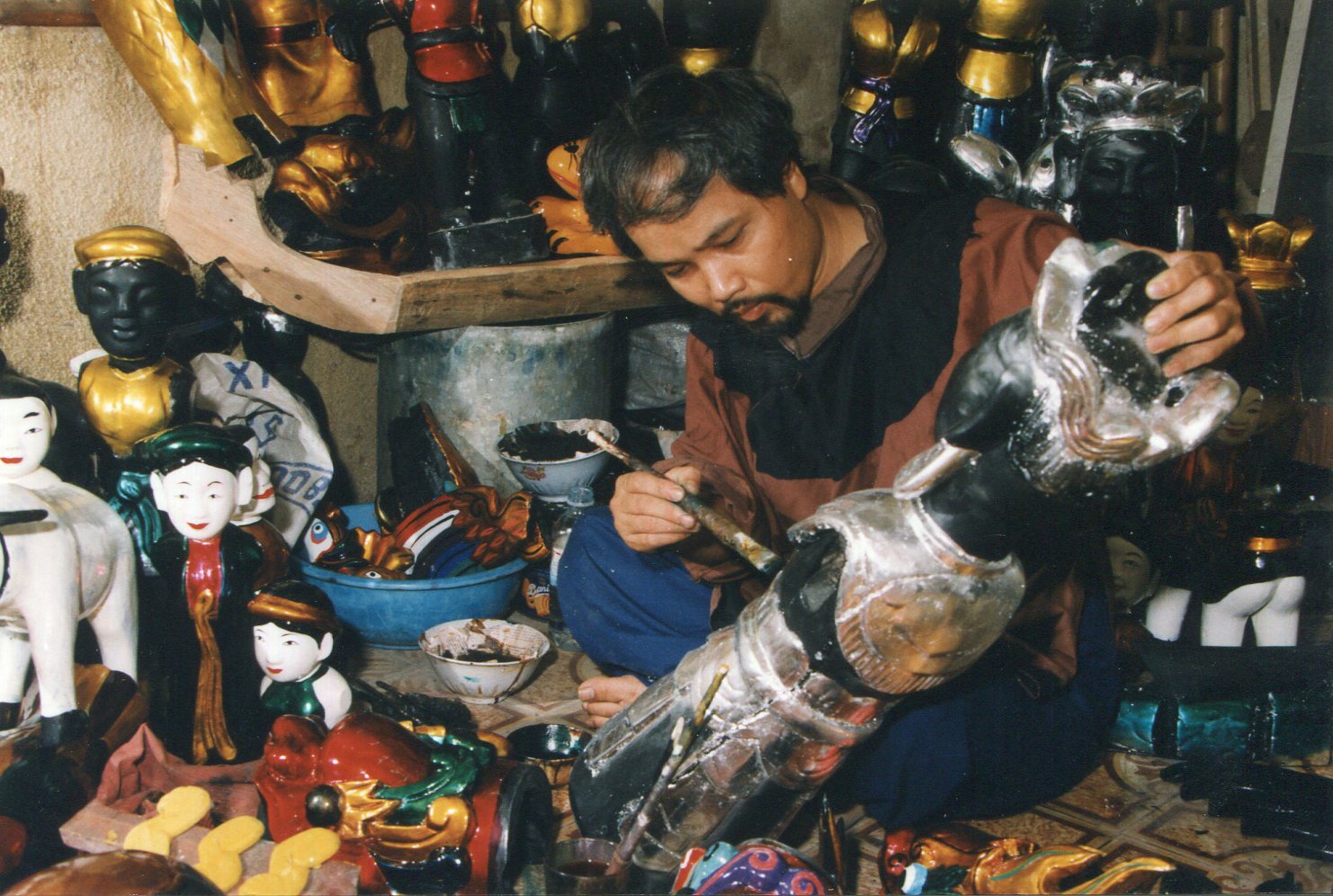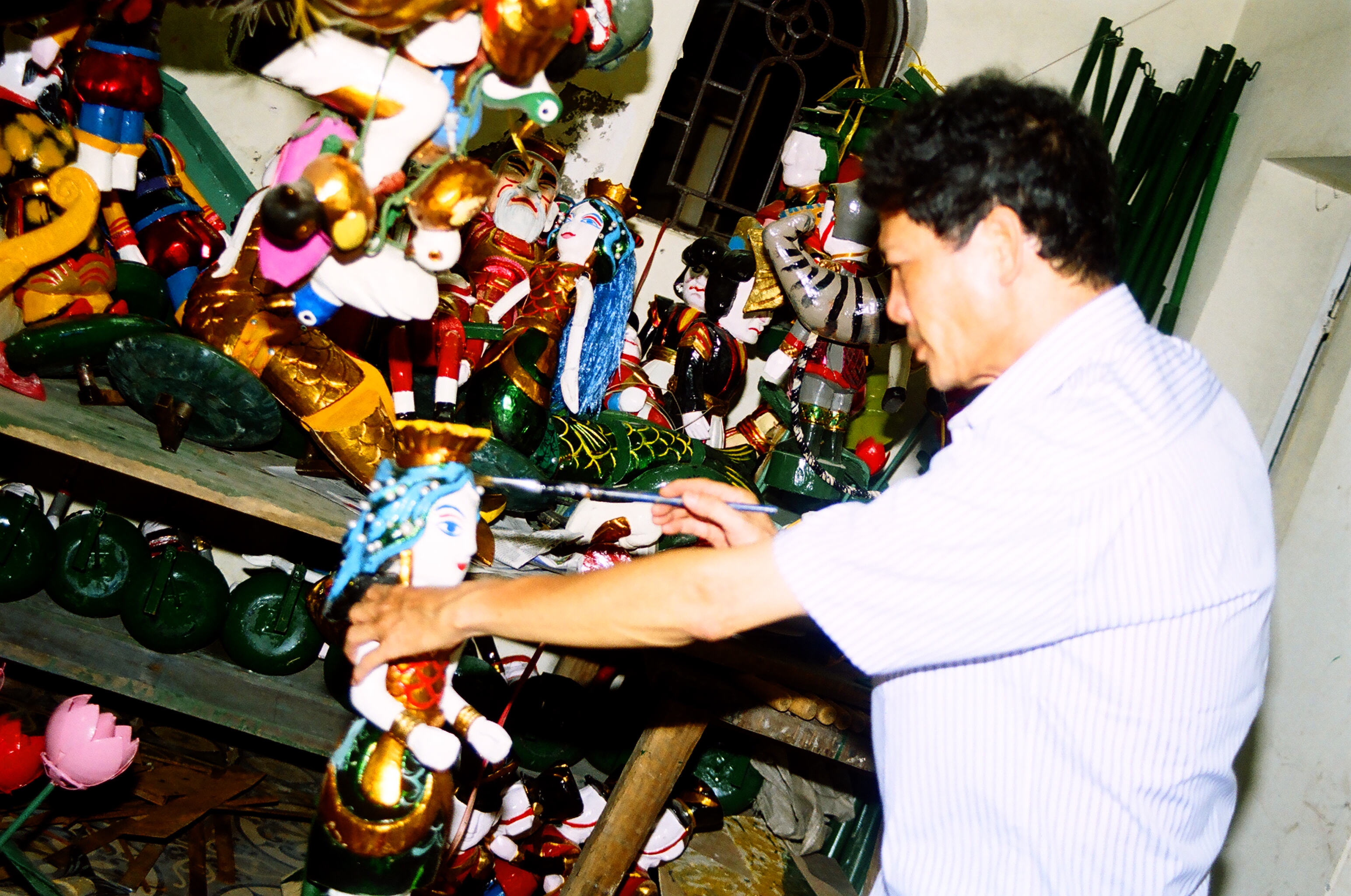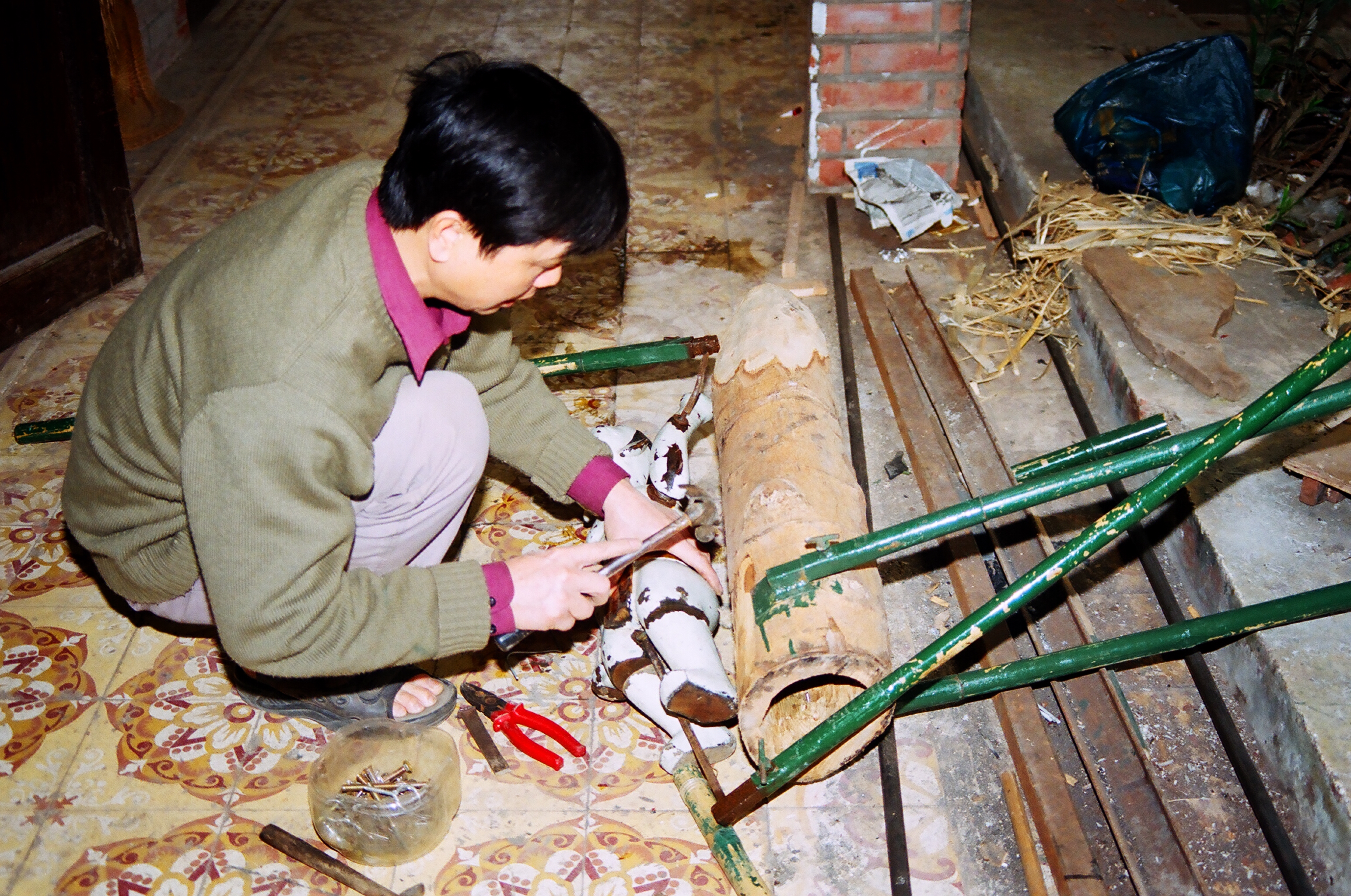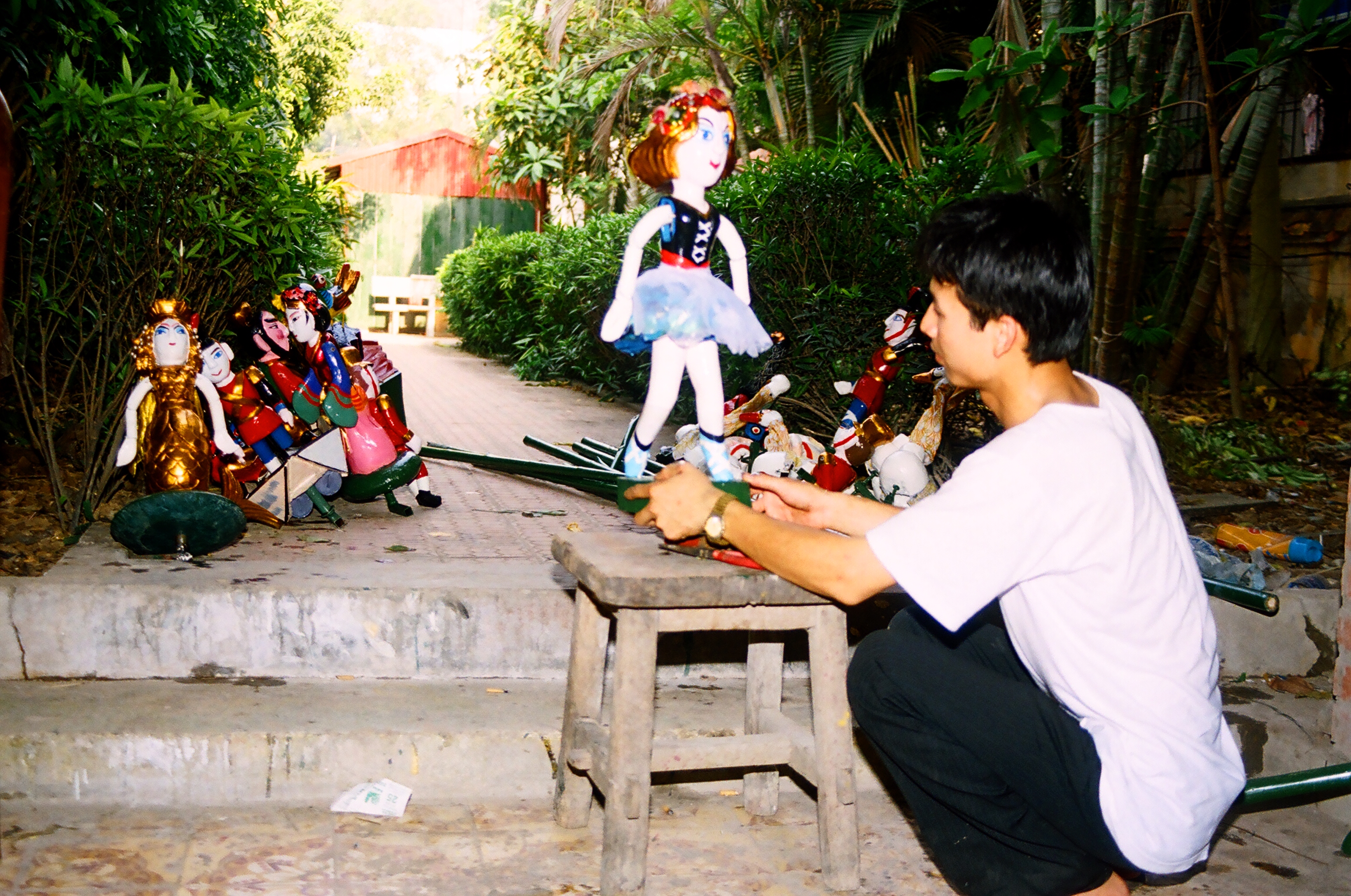Dang Anh Nga
Puppetry is a highly synthesis performance art. The center of the stage is the puppet. Without puppetry, there would be no puppet show stage – the face of the puppet show stage is the result of shape design and performance technique of the actor.

Puppetry appeared long ago in Vietnam, but no one knows when and where the puppetry appeared. According to the inscription on Sung Thien Dien Linh stone inscription (in 1121) in Nui Doi (Ha Nam province) was built in the second year of Thien Phu Du Vu, “....the puppet show was performed in the King's longevity wishing ceremony...” It proved that the puppetry skills as well as the puppetry art at that time reached a high level, were very skillful and had a long time of performance.

In the past, because there was no writing, our forefathers did not save important events for posterity. Since the beginning of writing, they were saved for posterity – including the activities of puppetry (on Sung Thien Dien Linh stone inscription). According to Prof. Tran Quoc Vuong (in Bac Ninh, on April 9, 2002), the archaeological site in Phap Van Pagoda shows that the puppetry was in existence at the end of the second and the beginning of the third century. Regarding the rule of natural development, the puppetry must appear sooner. This can only be judged based on folklore. Puppetry was brewing from Hung King period. Legend of Golden Turtle God from the river emerged to give An Duong Vuong the claw to make the magic crossbow, legend of White Chicken God broke the fortresses, etc are examples of land puppet show and water puppet show.

As an synthesis performance art, on the puppet show stage, there are the arts such as sculpture, painting, architecture, music, etc. Puppetry in the form of DYNAMIC ART: audience received puppetry in a dynamic state like cinema, singing, dancing and music.
The characteristic of puppetry art is the combination of shaping art and performing art. Referring to puppetry art, it is impossible not to mention the creativity of the designer. For the performance on stage, the contribution of the graphic artist can not be lacking.
Puppetry has a variety of puppet and stage design. The shape design and stage decoration contribute to the results of the repertoire. Puppet shaped design contributes to the puppetry art.
Firstly, the decision of the puppet type and stage is based on the script, then based on the intentions of staging the repertoire of the director. The shape design and fine art decoration for the repertoire require unity and empathy in the artistic creation between the director and the artist.
On the puppet show stage, the story is usually fairytales, parables, mythologies, etc. Therefore, puppetry is loved by children and it is the stage for very young audience.
Vietnamese puppetry was traditionally performed in folk-based guilds including water puppetry and land puppetry. In Complete Annals of Dai Viet, it was recorded that “...in the 12th year of Tan Dau, in February, took the birthday of the King to Thien Thanh day, took the bamboo into a strange way...” (Nguyen Huy Hong - Vietnamese Water Puppetry”, San khau Publisher, 1996). Thereby, we see the design work of the ancient artisans is very elaborate, worth studying.
The folk puppet shaped by the farmer artisans – they are skilled who built temples, pagodas, communal houses, carved ancient God and Buddha statues.
Due to geography, climate and living conditions, Vietnamese puppetry was created with unique characteristics, unlike neighboring countries’ puppetry. Although folk puppetry includes water puppetry and land puppetry, but water puppetry seems to be more popular. This is evidenced by the existence, activity and number of water puppet shows handed down to date. Natural environment and climatic conditions are the source of water puppetry. Agricultural life is the fulcrum and creative material for the water puppet shows.
The folk puppet shape is simple and realistic. The puppet shaped artisans simulate the puppets in a conventional way to express the content. Shaped on the basis of the fact, but not stereotyped. It is very suitable for the blending of puppet shape and the design of the machine controling the movement of the puppets. Puppets are have a funny appearance (such as children play with water, old duckeepers), also express the dream of its creator about the results of their work (fishing with big fishes) – these are the real aspirations of the workers.
The folk sculptors are the makers of puppets, but the puppets have their own vitality. Because the puppets are made for performance, their appearance is completely different from the Buddha and Saint statues in the temples. The Buddha and Saint statues are monolithic, have majestic appearance for the worship of the sanctuary. In contrast, the puppets have varieties of shapes (simulating the shapes of the working men), with joints to be able to move when controled. The spirit of puppets is funny. The color of the statues is illumination, but the puppets’ is more colorful. Painting for the puppets also depends on the cases.
The folk puppetry was interrupted for a period due to historical circumstances: The Ming Dynasty invader (1406) when occupying Vietnam wanted to destroy the native culture to assimilate the Vietnamese. The folk puppetry also fell into that general condition. The later feudal dynasties were interested in cultural development, but mainly literature and Tuong stage (in the Nguyen Dynasty). Puppetry is still active and handed down in folk. Some well-known guilds were invited to the capital to perform, but only that, no moreattention.
In the Later Le Dynasty (1533 – 1788) cultural activities were interested, including puppetry, so the water communal house was built in Thay pagoda (Ha Tay) to perform water puppet shows on the annual festivals.
On March 12, 1956, the puppetry sector had a historical development - according to President Ho Chi Minh, Minister of Culture Hoang Minh Giam signed the Decision on professional activities funded by the State. Thus, Vietnamese children have their own stage. The professional puppetry atives parallel to folk puppetry, learning and drawing the experience of folk puppetry combined with the knowledge and experience from international puppetry to complement their creativity and artistic activity.
- Puppetry is entering professional activity, so it has many innovations:
- Many professionals and actors are trained by the foreign art professionals (Czechoslovakia, Soviet Union, China).
- Train the actors in foreign countries under the university program or visit, practice (Czechoslovakia, Rumania).
- Join the International Puppetry Festivals and Symposia.
- Exchange puppetry guilds as exchange a national cultural exchange.
These activities have greatly enhanced the profession for the land puppetry. In the past, the land puppet show was widely admired by audience (including adults) with a number of repertoires in the following types of puppetry:
- Hand puppets (Trong com choir, in the bottom of the ocean, white goat - black goat, etc.)
- Stick puppets (Thach Sanh, Nung Phai – Gau Du, Tam – Cam, Dan Noi, etc.)
- Rope puppets (May and Ly, playing swing)
- Shadow puppets (Turtle and Crane)
- Flat puppets (The floral shirt)
- Puppets variety (Flag Dance, Lion Dance, Swan Lake, Kalinka...)
- Mask puppets (May and Ly, Holy Giong, Two maple, Boxing, etc.)
With the long puppet shows as well as repertoires in many types of stage and puppet shape, the design work also developed parallel to the performing arts. Regrettably, the previous successful puppet repertoires no longer exist. Puppets and decayed scenes were discarded or sold. The construction of the puppet museum at the present is difficult. The generation of puppeteers today is unaware of their forefathers’ work in the difficult difficult but glorious situation of professional puppetry.
From literary scripts to performance on stage, there are many things to consider. Firstly, the script must have conditions to create the play, must be a script for action (not only dialogue). Puppet characters have lively physical structures in action. A script with a good dialogue, interesting structure… is not necessarily suitable for the puppet show stage if not facilitate the acting of the characters on stage (at that time, the puppets only functioned as illustrations for literary scripts on stage).
When introducing drama characters to the puppet show stage it is necessary to have the conditions to emphasize (exaggerate, of course, must be based on fact) that audience (especially young children) can absorb. Creativity in shape design and fine art decoration must be based on fact.
The puppet show stage though for very young audience, but also can not arbitrarily, carelessly in the composition as well as negligence in artistic expression. Furthermore, with its unique feature and richness of expressive forms, the puppet show stage can “bear” and convey many problems that puppet makers want to express. The puppet show stage can also satisfy the demand for artistic enjoyment for older audience. It's not easy to get a good puppet show. It depends on the talent, common sensitivity and artistic sensitivity of the puppeteers.
Shape design and fine art decoration for puppet show stage is not like the actor stage (drama, cheo, tuong). Professional puppetry has been actived for nearly half a century, but many people mistakenly think that the shape design and decoration for the puppets is the same as costumes for the actor stage is just to create embryo puppets, dressing up, there will be puppet characters. There are even case that created embryos, then bought costumes for dressing up the embryos – has not follow the artist's outline – the performance without understanding of the profession or carelessly, negligence in shaping and decorating has contributed to the “amateurism” of the professional puppetry.

Water puppetry is an art product in the folk cultural treasures that needs to be preserved and promoted. But land puppetry is a “fertile ground” for the artistic creation of the puppeteers. Shape design and fine art decoration of puppetry plays an active role in the success of this art. The shaping and decorating of the puppets facilitate soar and success of the director and actor, or vice versa.
In the puppetry art, there is a high synthesis of other arts, the result is also synthesized. Therefore, there is a need for unity and synchronism among creative artists. The training also needs the synchronism: scriptwriter, director, fine art designer and actor. The synchronous training should not only focus on professional puppetry, but also pay attention to folk puppetry. In 2002, with funding from the Ford Foundation, the Bureau of Performing Arts presided over the support and training of artisans for succession of the traditional puppetry guilds in the Red River basin: a series of young artisans are trained, the performances of the guilds became exciting. But in shaping, artistic design reveals some things that can not be ignored, that is the puppets were painted sloppily. Artistic face of folk puppet show stage becomes a mess – What a pity! However, there are some guilds made “awful” puppets because it is too real (as visual aids for students), affecting the soar of the water puppet show stage. In addition, it became gassy with a series of minutiae, the audience can only “see” when sitting near the stage and puppets are in static state on grass (there is no convention, generalization, simulation, etc. of folk puppetry, harmony, impression and grace of the five colors also lost).
Over the long lime, some puppetry organizations have been very effective in performing folk puppet shows both inside and outside the country and are widely loved by audience. Meanwhile, the land puppetry is almost unnoticed. If only perform water puppet shows, though unique and proud, but the puppeteers will gradually become artisans who make and control the puppets, not become puppet creative artists.
Creating a new repertoire for the water puppet show stage should be based on real life, as our forefathers had created before. The actual situation of social life in cities today is not the environment for the creation of water puppetry. With the characteristics of the water puppet show stage, to creat a puppet script with plot, there should be space and context to convey the content. It is not simple without combination with land puppetry. Therefore, we – the puppeteer – should not overlook the land puppetry as it is extremely rich every aspect of artistic creation of this art.
In the current social circumstances, puppet show stage not only stands alone, but around it there also other attractions attracting very young audience. Unlike before, the audience came to the puppetry, today the puppetry must find the audience. This field is really hard. In order to get results, everything is looking forward to the tirelessly creative work of puppeteers ourselves.
Hanoi, April 10, 2003



